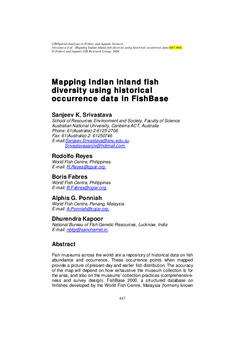Mapping Indian inland fish diversity using histoical occurrence data in Fishbase

Citation
Srivastava, S.K. et al. (2004). Mapping Indian inland fish diversity using histoical occurrence data in Fishbase. p. 447-464. In:Fishery and Aquatic GIS Research Group. Second International Symposium on GIS/Spatial Analyses in Fishery and Aquatic Sciences, University of Sussex, Brighton, UK. 3-6 September 2002
Fish museums across the world are a repository of historical data on fish abundance and occurrence. These occurrence points when mapped provide a picture of present-day and earlier fish distribution. The accuracy of the map will depend on how exhaustive the museum collection is for the area, and also on the museums’ collection practices (comprehensiveness and survey design). FishBase 2000, a structured database on finfishes developed by the World Fish Centre, Malaysia (formerly known as ICLARM-The World Fish Centre), contains more than 3500 data sets on the occurrence point of over 300 inland fishes of India. The occurrence information in the FishBase that covers a wide temporal range (1816 to 1998) has been compiled from seven museums external to India. Due to heterogeneity in source and period, most of the location names were not standardized and there was a need to relate these with the names in use presently. To identify all the names, a methodology was developed to assign the co-ordinates to all the occurrence points using different geo-registered base maps, old maps of India and information compiled from websites using a specific search strategy. With the mapping of all the occurrence points, it was possible to list the fish species found within individual broad political and geographical regions of India using Arc View 3.1 software. Different ecological areas were identified from different parts of India to compare the regions based on fish species composition and to see the effectiveness of the database at fine and coarse scales. The database was also compared with some other reports to assess its accuracy. The present study has indicated that it would be possible to extrapolate the museum occurrence data compiled in FishBase into distribution, provided occurrence points could be validated and enriched by additional data sets. However, lack of base maps and habitat information for the fish concerned were the limiting factors.
Permalink
Date Available
Type
Publisher
Countries
Language